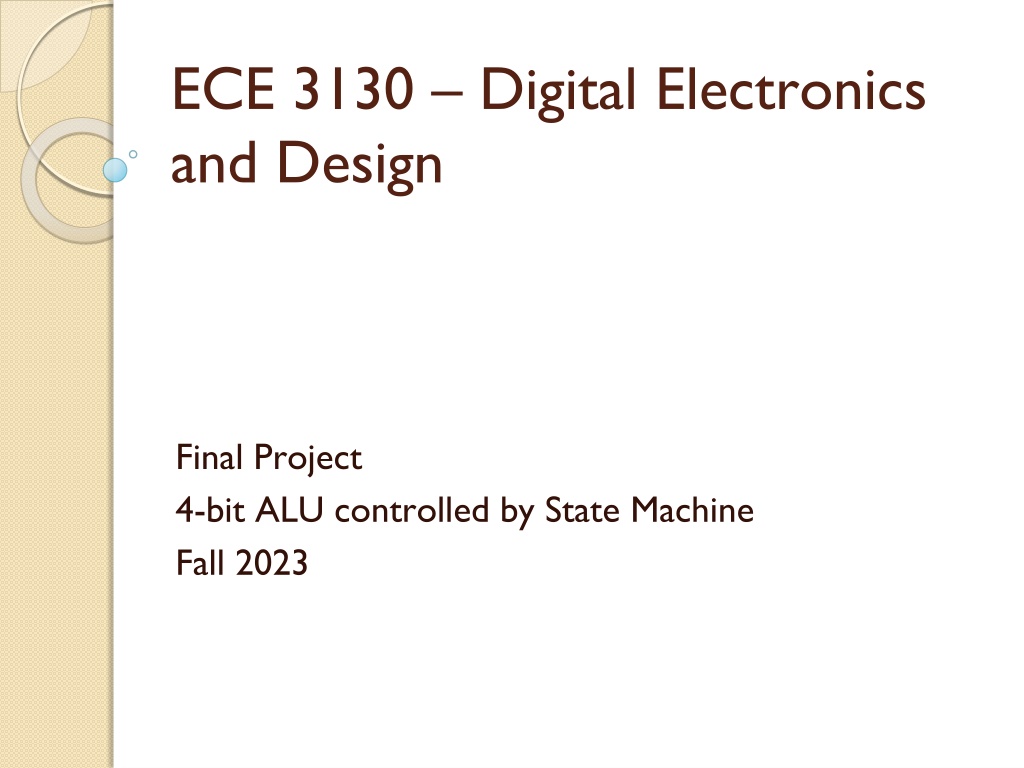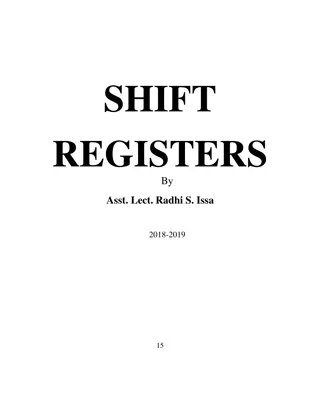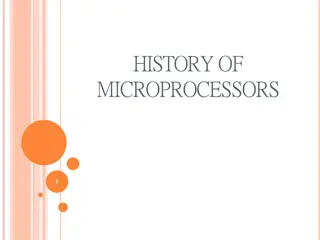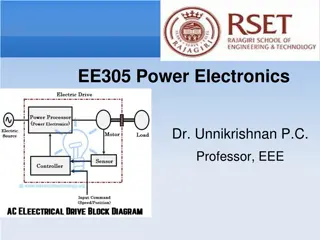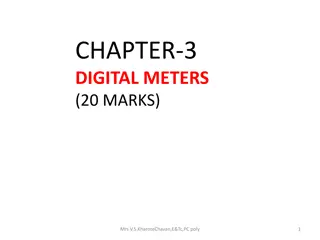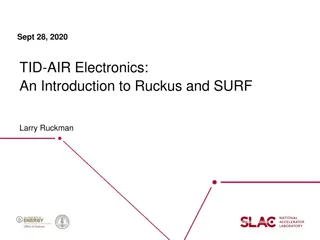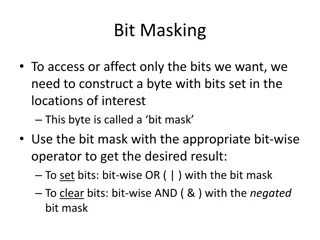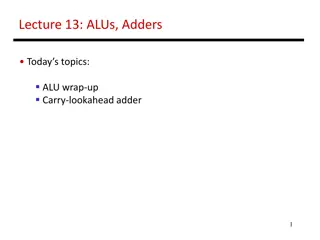Digital Electronics and Design Fall 2023 Final Project: 4-bit ALU Controlled by State Machine
This project involves designing a 4-bit Arithmetic Logic Unit (ALU) controlled by a State Machine. The ALU performs operations such as addition, subtraction, resetting to zero, and holding results based on select signals. The system includes input and output D Flip-Flops (DFFs) with clear pins, MUX for selecting outputs, and State Machines for controlling signals and operation states. The design utilizes DFFs for input and output data, with the clear pin controlled by the State Machine for enabling data flow.
Download Presentation

Please find below an Image/Link to download the presentation.
The content on the website is provided AS IS for your information and personal use only. It may not be sold, licensed, or shared on other websites without obtaining consent from the author. Download presentation by click this link. If you encounter any issues during the download, it is possible that the publisher has removed the file from their server.
E N D
Presentation Transcript
ECE 3130 Digital Electronics and Design Final Project 4-bit ALU controlled by State Machine Fall 2023
Overall Diagram Inputs State Machine (Controller) Control signals Inputs Outputs DFFs with clear pin (Switch on/off) DFFs with clear pin (Switch on/off) 4-bit ALU
Part 1: 4-bit ALU S1 S0 R0 R1 R2 R3 A0 A1 A2 A3 4-bit ALU B0 B1 B2 B3 Carry/Borrow Out A0-A3 are 4-bit input data A[3:0]. B0-B3 are 4-bit input data B[3:0]. R0-R3 are 4-bit output data R[3:0]. Carry/Borrow Out is 1-bit output data which is used for addition/subtraction. S0-S1 are 2-bit input data that are used to select operations.
Part 1: 4-bit ALU Values of select signal S[1:0] & four functions S1 S0 Functions 0 0 No change 0 1 A plus B 1 0 A minus B 1 1 Reset to zero Select signal S1 and S0 are controlled and given by State Machine based on different states. PS. No change means the previous calculation results of ALU are held and locked. It s different from being reset to zero.
Use MUX to select output Take R0 for example: No change Adder_ Output R0 4 to 1 MUX Subtractor Output Zero
Part 2: DFFs at input side clear S1 S0 Q A0 D R0 R1 R2 R3 A0 clock . . . . . . . 4-bit ALU clear B3 Carry/Borrow Out B3 Q D clock Eight DFFs are needed at the input side to provide 8 bits input data for ALU(A0-A3, B0- B3). The value of clear pin is controlled by State Machine. When it s at high level, DFF is switched on, and thus ALU is able to obtain the input data. When it s at low level, DFF is reset, and thus all the inputs of ALU are zero.
Part 3: DFFs at output side clear S1 S0 Q D R0 R0 A0 A1 A2 A3 clock . . . . . . . . 4-bit ALU B0 B1 B2 B3 clear Carry/Borrow Out Q D Carry/Borrow Out clock 5 DFFs are needed at the output side to send out 5 bits output data of ALU(R0-R3, Carry/Borrow Out). The value of clear pin is controlled by State Machine. When it s at high level, DFF is switched on, and thus results of ALU are able to be sent out. When it s at low level, DFF is reset, and thus results of ALU cannot be sent out.
Part 4: Moore State Machine -- State Diagram [X1,X0]=00 [X1,X0]=00 State 0 State 0 [S1,S0]=00 [S1,S0]=00 Ie=0 Ie=0 Oe=0 Oe=0 [X1,X0]=01,10,11 [X1,X0]=01,10,11 [X1,X0]=00,01,11 [X1,X0]=00,01,11 State 1 State 1 [S1,S0]=00 [S1,S0]=00 Ie=1 Ie=1 Oe=0 Oe=0 State 5 State 5 [S1,S0]=00 [S1,S0]=00 Ie=1 Ie=1 Oe=1 Oe=1 State 2 State 2 [S1,S0]=01 [S1,S0]=01 Ie=1 Ie=1 Oe=0 Oe=0 State 3 State 3 [S1,S0]=10 [S1,S0]=10 Ie=1 Ie=1 Oe=0 Oe=0 State 4 State 4 [S1,S0]=11 [S1,S0]=11 Ie=1 Ie=1 Oe=0 Oe=0
Part 4: Moore State Machine State 0: Initial state. In this state, all DFFs at both sides are switched off. ALU do not have any input data. No operation is selected for ALU. The output of ALU are not sent out. State 1: Fetching state. In this state, the DFFs at input side are switched on. Input data are sent into ALU and ready to be calculated. State 2,3,4: Calculating state. In these states, one of the operations of ALU is selected. Results are calculated out by ALU, but not sent out yet. State 5: Sending out state. In this state, the DFFs at output side are switched on. The calculation results of ALU are sent out.
Part 4: Moore State Machine -- Symbol A B C X1 X0 Moore State Machine S1 S0 Ie Oe reset clock X0-X1 are 2-bit input data, which is used to determine the next state in State Machine. A,B,C are 3-bit output data, which are used to indicate the number of current state. In this project, they do not need to be connected to anything. S0-S1 are 2-bit output data, which are used to provide corresponding select signals of ALU. Ie is 1-bit output data, which is used to control switch on/off of eight DFFs at input side. It should be connected to the clear pins of DFFs. Oe is 1-bit output data, which is used to control switch on/off of nine DFFs at output side. It should be connected to the clear pins of DFFs.
Tips: Try to find the simplified Boolean equations for the Moore FSM You can use Boolean Algebra Solver to verify your calculation Refer to lab 9
Symbol of the whole project X1 X0 A0 A1 A2 A3 R0 R1 R2 R3 Final Project B0 B1 B2 B3 Carry/Borrow Out reset clock A0-A3 and B0-B3 are used to provide data inputs of eight DFFs at input side. X0-X1 and reset are connected to corresponding inputs of State Machine. Clock is used to provide clock signals for both State Machine and all DFFs. R0-R3 and Carry/Borrow Out are connected to corresponding outputs of 5 DFFs at output side.
Test and Simulation Moore State Machine should be tested separately to ensure all the functions are correct. For example, all the state transitions under different inputs(X1,X0) are correct. All the corresponding outputs in different states are correct. For the test of whole project, choose five groups of input data A[3:0] and B[3:0]. For each group of input data, set up proper values of X1-X0 and verify all three ALU operations (addition, subtraction, no change).
Two or Three students per group Individual Report due date:TBD Write the steps of your report in details Usual expectations : schematic, waveform and analysis Plus: Original Tanner Project file in a zip
